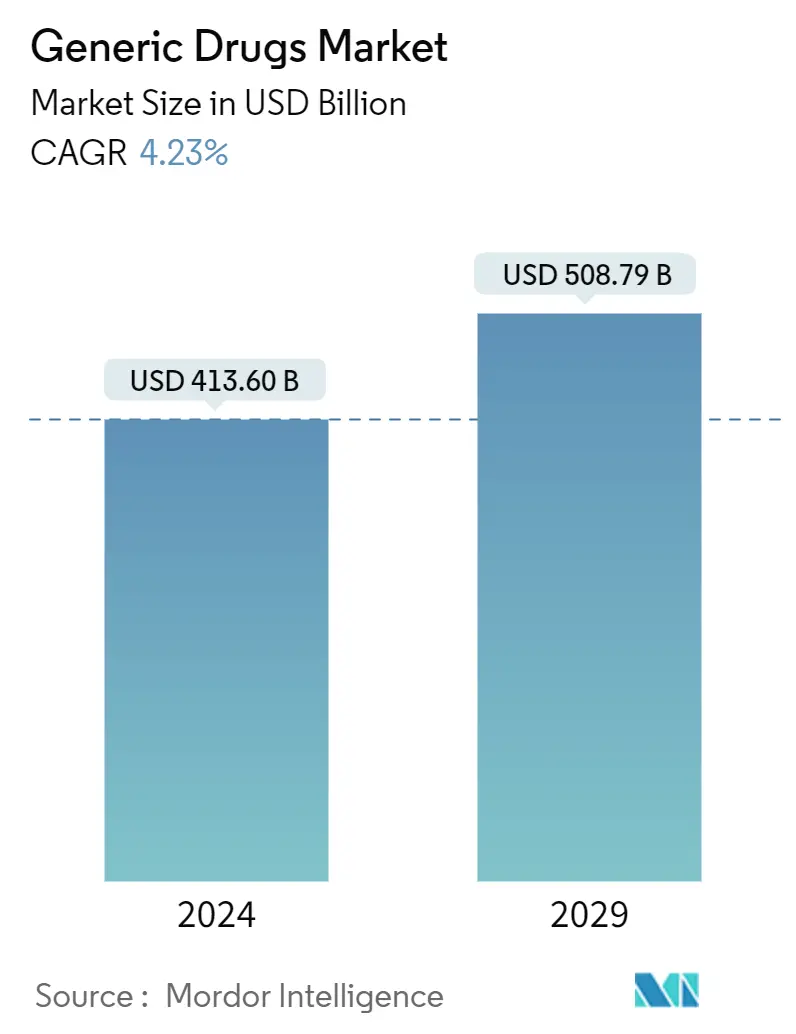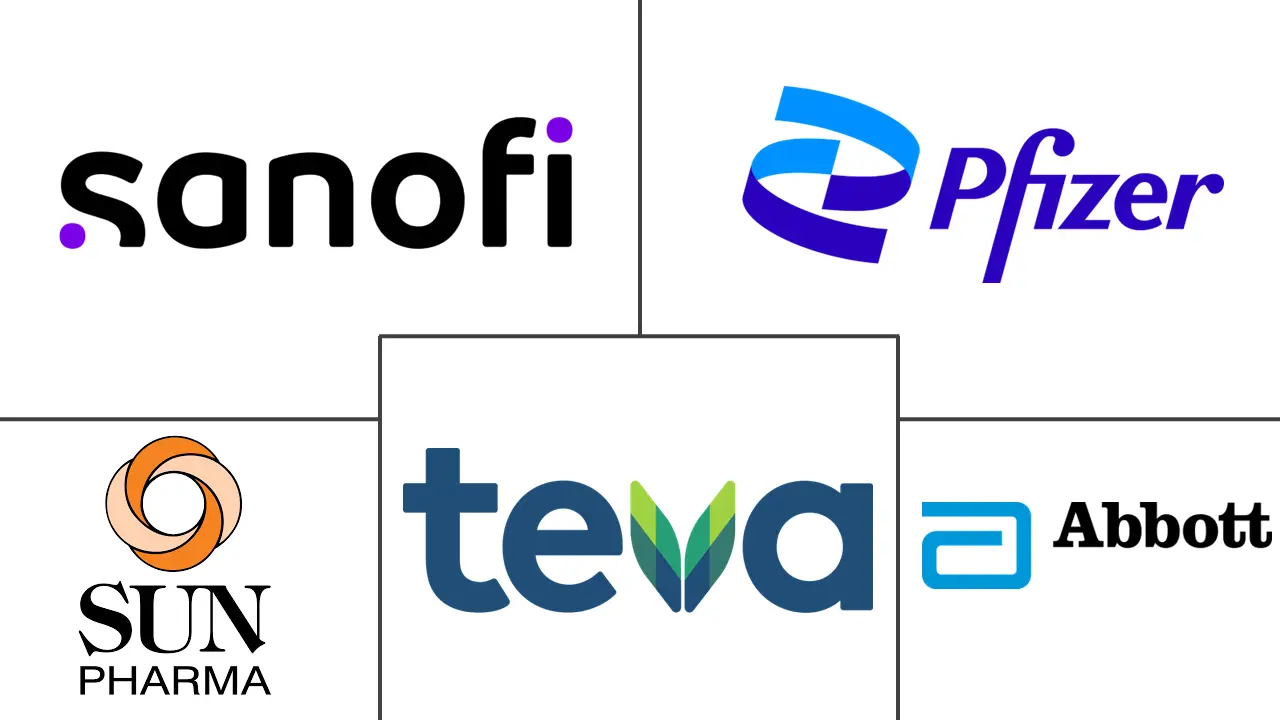Market Size of Generic Drugs Industry

| Study Period | 2021 - 2029 |
| Market Size (2024) | USD 413.60 Billion |
| Market Size (2029) | USD 508.79 Billion |
| CAGR (2024 - 2029) | 4.23 % |
| Fastest Growing Market | Asia-Pacific |
| Largest Market | North America |
| Market Concentration | Medium |
Major Players
*Disclaimer: Major Players sorted in no particular order |
Generic Drugs Market Analysis
The Generic Drugs Market size is estimated at USD 413.60 billion in 2024, and is expected to reach USD 508.79 billion by 2029, growing at a CAGR of 4.23% during the forecast period (2024-2029).
The rising prevalence of chronic diseases has spurred the demand for affordable medications, driving the Generic Medicine Market. Their lower cost, compared to branded alternatives, is a significant factor fueling their adoption in developing and developed economies. Additionally, as patents expire on blockbuster drugs, the market is witnessing a surge in the development of generic versions, further propelling the growth of the Generic Pharmaceuticals Market.
Chronic diseases such as diabetes, cardiovascular diseases, respiratory diseases, and various cancers require ongoing medication use. The high prevalence of cardiovascular diseases is propelling the growth of the Generic Drugs Market. For instance, coronary artery disease has risen at a high rate in recent years. According to a report published by the Centers for Disease Control and Prevention in May 2023, coronary heart disease is the most prevalent form of heart disease. Approximately 5% of adults aged 20 years and older, or one in 20, are affected by coronary artery disease (CAD) globally.
According to the same source, every year, about 850,000 people in the United States have a heart attack. Among these, 605,000 have had their first heart attack, and over 200,000 people have already had a heart attack. This presents a substantial market opportunity for the United States Generic Drugs Market, as the demand for cost-effective medications used during treatment contributes significantly to the growth of the Generic Drugs Market.
Moreover, the increasing prevalence of diabetes cases worldwide is projected to drive the global rise in diabetes cases and is expected to propel market growth during the forecast period. For instance, according to a report published by the Institute for Health Metrics and Evaluation in June 2023, the number of diabetes cases is projected to increase from 529 million in 2022 to 1.3 billion by 2050. The rising prevalence of chronic diseases is anticipated to drive the demand for effective treatments, thereby propelling the growth of the Global Generic Drugs Market during the forecast period. Furthermore, the implementation of various organic and inorganic strategies by key market players is expected to bolster market expansion. For instance, in May 2024, Gland Pharma Limited, Hikma Pharmaceuticals USA Inc., Long Grove Pharmaceuticals LLC, and Dr. Reddy's Laboratories Limited received approval for Edaravone Intravenous Solutions intended for the treatment of amyotrophic lateral sclerosis, a progressive neurodegenerative disease which is a generic alternative of Radicava, contributing to the expansion of the Generic Drug Manufacturing sector.
In conclusion, the increasing incidence of chronic diseases, combined with the strategic initiatives of leading industry players, is projected to significantly enhance the growth of the Generic Pharmaceutical Industry in the coming years.
However, stringent government regulations and a short supply of generic drugs in the market are expected to restrain market growth during the forecast period.
Generic Drugs Industry Segmentation
As per the scope of this report, a generic drug is a pharmaceutical drug that contains the same chemical substance as that used for the patented molecule. A generic drug is only allowed onto the market when its original drug's patent period expires. It is a molecule now allowed to be sold by all the players under a different brand name. The generic drugs market is segmented by route of administration, application, distribution channel, and geography. The route of administration segment is further divided into oral, topical, injectable, and other routes of administration. The application segment is further segmented into cardiovascular products, anti-infective drugs, central nervous system drugs, anti-cancer drugs, respiratory products, and other applications. The end user segment is further bifurcated into hospitals/clinics, retail pharmacies, and other distribution channels. The geography segment is further divided into North America, Europe, Asia-Pacific, Middle East and Africa, and South America. The market report also covers the estimated market sizes and trends for 17 different countries across major regions globally. The report offers the value (USD) for the above segments.
| By Route of Administration | |
| Oral | |
| Topical | |
| Injectable | |
| Other Routes of Administration (Sublingual, Rectal) |
| By Application | |
| Cardiovascular Products | |
| Anti-infective Drugs | |
| Anti-arthritis Drugs | |
| Central Nervous System Drugs | |
| Anti-cancer Drugs | |
| Respiratory Products | |
| Other Applications (Gastrointestinal, Hormonal Drug) |
| By Distribution Channel | |
| Hospitals/Clinics | |
| Retail Pharmacies | |
| Other Distribution Channels (Online Pharmacy, Specialty Drug Stores) |
| By Geography | ||||||||
| ||||||||
| ||||||||
| ||||||||
| ||||||||
|
Generic Drugs Market Size Summary
The generic drugs market is poised for significant growth, driven by the increasing prevalence of chronic diseases and the demand for affordable medications. As patents on major pharmaceuticals expire, the market is experiencing a surge in the development of generic alternatives, which are more cost-effective than their branded counterparts. This trend is particularly evident in both developing and developed economies, where the need for budget-friendly treatment options is paramount. The rise in chronic conditions such as diabetes, cardiovascular diseases, and cancers is further propelling market expansion, as these ailments require ongoing medication. The strategic initiatives by key industry players, including product launches and collaborations, are expected to bolster market growth during the forecast period.
North America is anticipated to hold a substantial share of the global generic drugs market, attributed to the high prevalence of chronic diseases and the increasing focus on cost-effective treatments. The region's market growth is supported by the rising incidence of conditions like diabetes and cancer, which drive the demand for generic medications. Strategic activities such as partnerships, mergers, and acquisitions among major market players are also contributing to the market's expansion. The competitive landscape is characterized by significant investments in research and development, alongside product innovations, as companies strive to maintain their market positions. Key players in the market include Mylan NV, Eli Lilly and Company, GlaxoSmithKline PLC, Pfizer Inc., Sun Pharmaceutical Industries Ltd., Novartis AG, and Sanofi, all of which are actively engaged in enhancing their product offerings and expanding their market reach.
Generic Drugs Market Size - Table of Contents
-
1. MARKET DYNAMICS
-
1.1 Market Overview
-
1.2 Market Drivers
-
1.2.1 Increasing Prevalence of Chronic Diseases
-
1.2.2 Rise in Geriatric Population
-
1.2.3 Increase in Healthcare Expenditure
-
-
1.3 Market Restraints
-
1.3.1 Stringent Government Regulations
-
1.3.2 Adverse Effects Associated With the Drugs
-
-
1.4 Porter's Five Forces Analysis
-
1.4.1 Threat of New Entrants
-
1.4.2 Bargaining Power of Buyers/Consumers
-
1.4.3 Bargaining Power of Suppliers
-
1.4.4 Threat of Substitute Products
-
1.4.5 Intensity of Competitive Rivalry
-
-
-
2. MARKET SEGMENTATION (Market Size by Value - USD)
-
2.1 By Route of Administration
-
2.1.1 Oral
-
2.1.2 Topical
-
2.1.3 Injectable
-
2.1.4 Other Routes of Administration (Sublingual, Rectal)
-
-
2.2 By Application
-
2.2.1 Cardiovascular Products
-
2.2.2 Anti-infective Drugs
-
2.2.3 Anti-arthritis Drugs
-
2.2.4 Central Nervous System Drugs
-
2.2.5 Anti-cancer Drugs
-
2.2.6 Respiratory Products
-
2.2.7 Other Applications (Gastrointestinal, Hormonal Drug)
-
-
2.3 By Distribution Channel
-
2.3.1 Hospitals/Clinics
-
2.3.2 Retail Pharmacies
-
2.3.3 Other Distribution Channels (Online Pharmacy, Specialty Drug Stores)
-
-
2.4 By Geography
-
2.4.1 North America
-
2.4.1.1 United States
-
2.4.1.2 Canada
-
2.4.1.3 Mexico
-
-
2.4.2 Europe
-
2.4.2.1 United Kingdom
-
2.4.2.2 Germany
-
2.4.2.3 France
-
2.4.2.4 Italy
-
2.4.2.5 Spain
-
2.4.2.6 Rest of Europe
-
-
2.4.3 Asia-Pacific
-
2.4.3.1 China
-
2.4.3.2 Japan
-
2.4.3.3 India
-
2.4.3.4 Australia
-
2.4.3.5 South Korea
-
2.4.3.6 Rest of Asia-Pacific
-
-
2.4.4 Middle East and Africa
-
2.4.4.1 GCC
-
2.4.4.2 South Africa
-
2.4.4.3 Rest of Middle East and Africa
-
-
2.4.5 South America
-
2.4.5.1 Brazil
-
2.4.5.2 Argentina
-
2.4.5.3 Rest of South America
-
-
-
Generic Drugs Market Size FAQs
How big is the Generic Drugs Market?
The Generic Drugs Market size is expected to reach USD 413.60 billion in 2024 and grow at a CAGR of 4.23% to reach USD 508.79 billion by 2029.
What is the current Generic Drugs Market size?
In 2024, the Generic Drugs Market size is expected to reach USD 413.60 billion.

